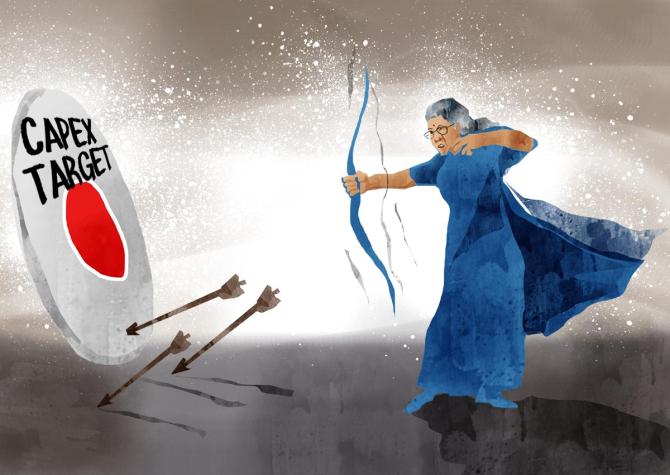Investment growth comes up short despite govt’s capex push
Investment growth moderated slightly in the economy during the first quarter (Q1) of the current financial year (2023-24, or FY24), notwithstanding the front-loading of capital expenditure (capex) by the Centre.
This was also the case despite a pick-up in demand during the period after two dismal consecutive quarters.
Although growth in gross fixed capital formation (GFCF), representing investment, fell to a five-quarter low of 7.96 per cent, the comparison with the first two quarters of the previous year is a bit askew due to the low year-on-year (Y-o-Y) base of those periods.
When comparing the investment growth rate in Q1 of this financial year with the previous two quarters, the fall was not too significant.
Growth was 7.99 per cent in the third quarter (Q3) and 8.92 per cent in the fourth quarter (Q4) of 2022-23 (FY23).
The moderation is reflected in the share of GFCF in gross domestic product (GDP), which once again fell below 30 per cent to 29.3 per cent in Q1FY24, compared to 31.7 per cent in Q4 of the previous financial year.
Investment growth above 30 per cent is considered important for driving economic growth.
This was despite heavy capex by the Centre, which grew 57 per cent to Rs 2.8 trillion in Q1FY24 Y-o-Y.
However, the Centre’s capex constituted just 13 per cent of the total investment at Rs 20.7 trillion during the quarter.
With states also contributing around that figure, much of the investment fell into the hands of the private sector.
The private sector’s investment is yet to see any significant pick-up.
Experts believe that investments remain high despite some deceleration in Q1FY24.
ICRA’s chief economist Aditi Nayar says GFCF grew at a robust pace in Q1FY24, notwithstanding the deceleration vis-à-vis Q4FY23.
Bank of Baroda’s chief economist Madan Sabnavis says capital formation has been maintained at 29.3 per cent of GDP, which is a good sign, though it was mainly due to government spending.
Private final consumption expenditure (PFCE), representing demand in the economy, rose by around 6 per cent in Q1FY24, after a dismal 2.17 per cent in Q3 and 2.83 per cent in Q4 of the previous year.
The share of PFCE in GDP rose to 59.7 per cent from 58.4 per cent in Q4FY23.
However, it was less than the 63.2 per cent in Q3 and 61.5 per cent in the second quarter of FY23.
Economists, however, believe that the economy still witnesses a K-shaped recovery, which makes demand in the economy lopsided in favour of the rich.
India Ratings & Research’s principal economist Sunil K Sinha observes that a broad-based recovery in PFCE is still some distance away.
“The current consumption demand is skewed towards goods and services consumed largely by households falling in the higher income bracket,” he says.
Moreover, the high inflation rate in the ongoing quarter may further dent demand from the poor in the economy.
With the government front-loading capex, it applied brakes to its revenue expenditure.
As such, government final consumption expenditure (GFCE) fell by 0.7 per cent in Q1FY24, against growth of 2.3 per cent in Q4FY23.
The share of GFCE in GDP fell to 10.5 per cent in Q1 of the current financial year, against 12.1 per cent in Q4FY23.
Source: Read Full Article


